DATSUN 210 1979 Service Manual
Manufacturer: DATSUN, Model Year: 1979, Model line: 210, Model: DATSUN 210 1979Pages: 548, PDF Size: 28.66 MB
Page 331 of 548
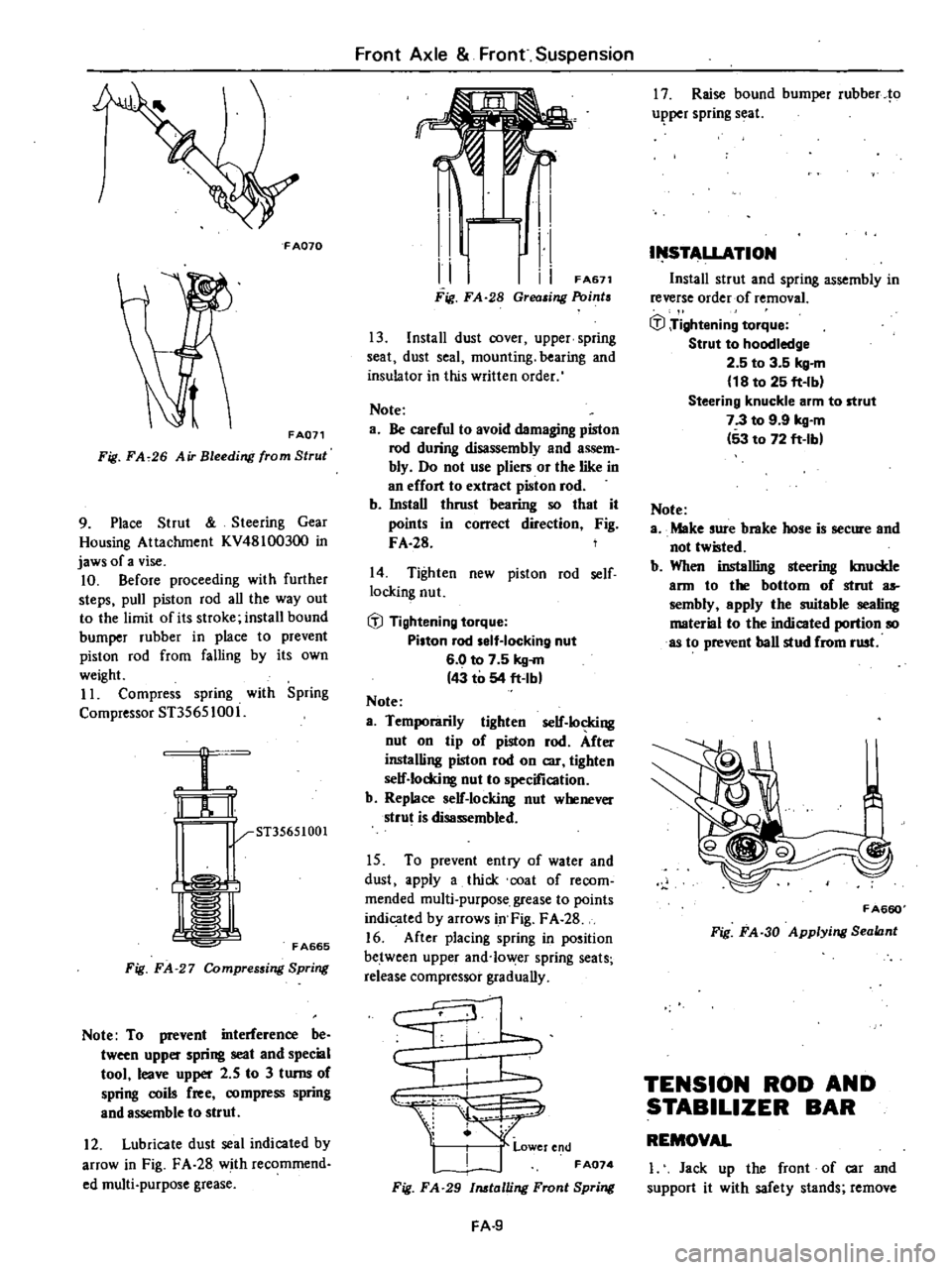
FA070
FA071
Fig
FA
26
Air
Bleeding
from
Strul
9
Place
Strut
Steering
Gear
Housing
Attachment
KV48100300
in
jaws
of
a
vise
10
Before
proceeding
with
further
steps
pull
piston
rod
all
the
way
out
to
the
limit
of
its
stroke
install
bound
bumper
rubber
in
place
to
prevent
piston
rod
from
falling
by
its
own
weight
11
Compress
spring
with
Spring
Compressor
ST35651001
ST35651001
r
l
I
FA665
Fig
FA
27
Compressing
Spring
Note
To
prevent
interference
be
tween
upper
spring
seat
and
special
tool
leave
upper
2
5
to
3
turns
of
spring
coils
free
compress
spring
and
assemble
to
strut
12
Lubricate
dust
seal
indicated
by
arrow
in
Fig
FA
28
with
recommend
ed
multi
purpose
grease
Front
Axle
Front
Suspension
I
1
i
I
FA671
Fig
FA
28
Grea
ing
Point
13
Install
dust
cover
upper
spring
seat
dust
seal
mounting
bearing
and
insulator
in
this
written
order
Note
a
Be
careful
to
avoid
damaging
piston
rod
during
disassembly
and
assem
bly
Do
not
use
pliers
or
the
like
in
an
effort
to
extract
piston
rod
b
InstaU
thrust
bearing
so
that
it
points
in
correct
direction
Fig
FA
28
14
Tighten
new
piston
rod
self
locking
nut
fil
Tightening
torque
Pi
ton
rod
elf
Iocking
nut
6
0
to
7
5
kg
m
43
to
54
ft
lbl
Note
a
Temporarily
tighten
self
locking
nut
on
tip
of
piston
rod
After
installing
piston
rod
on
car
tighten
self
locking
nut
to
specification
b
Replace
self
locking
nut
whenever
strut
is
disassembled
15
To
prevent
entry
of
water
and
dust
apply
a
thick
coat
of
recom
mended
multi
purpose
grease
to
points
indicated
by
arrows
in
Fig
F
A
28
16
After
placing
spring
in
position
between
upper
and
lo
er
spring
seats
release
compressor
graduaUy
I
J
k
1
jt
r
end
FA074
Fig
FA
29
talling
Front
Spring
FA
9
17
Raise
bound
bumper
rubber
10
u
per
spring
seal
I
STALLATION
Install
strut
and
spring
assembly
in
reverse
order
of
removaL
fil
Tightening
torque
Strut
to
hoodledge
2
5
to
3
5
kg
m
18
to
25
ft
Ib
Steering
knuckle
arm
to
strut
7
3
to
9
9
kg
m
53
to
72
ft
lb
Note
a
Make
sure
brake
hose
is
secure
and
not
tw
ted
b
When
installing
steering
knuckle
ann
to
the
bottom
of
strut
as
sembly
epply
the
suitable
sealing
material
to
the
indicated
portion
so
as
to
prevent
ball
stud
from
rust
FA660
Fig
FA
30
Applying
Sealant
TENSION
ROD
AND
STABILIZER
BAR
REMOVAL
I
Jack
up
the
front
of
car
and
support
it
with
safety
stands
remove
Page 332 of 548

wheels
2
Remove
splaahboard
if
necessary
3
Back
off
nut
securing
tension
rod
to
bracket
and
remove
bolts
which
secure
tension
rod
to
lower
arm
Tension
rod
can
then
be
taken
out
4
Remove
nuts
securing
stabilizer
bar
to
connecting
rod
Note
Two
wrenches
are
n
1
in
this
B
5
Remove
bolts
and
nuts
securing
stabilizer
bar
bracket
in
position
Stabilizer
bar
can
then
be
iaken
o
t
CV
3
@
I
Lower
ann
5
Tension
rod
2
Stabilizer
bar
bracket
connecting
rod
6
Tension
rod
3
Stabilizer
bar
4
Stabilizer
bar
bracket
FA129
Fig
FA
31
Removing
Tension
Rod
and
Stabilizer
Bar
INSPECTION
I
Check
tension
rod
and
stabilizer
bar
for
evidence
of
deformation
or
cracks
if
necessary
replace
2
Check
rubber
parts
such
as
ten
sion
rod
and
stabilizer
bar
bushings
to
be
sure
they
are
not
deteriorated
or
cracked
if
1ecessary
replace
INSTAllATION
Install
tension
rod
and
stabilizer
bar
in
tJ
1e
reverse
order
of
removal
noting
the
following
I
Be
sure
stabilizer
bar
is
not
closer
to
either
side
but
is
located
at
the
middle
If
stabilizer
bar
is
new
use
the
following
procedure
to
center
the
stabilizer
bar
Position
arm
with
white
paipt
mark
toward
left
side
of
car
Front
Axle
Front
Suspension
Set
slabillz
rliar
mount
bushingS
So
that
outer
side
of
stabilizer
bar
bushing
is
brought
into
inner
side
of
marking
e
o
I
19
e
1
Marking
2
Bushing
3
Marking
4
While
painting
5
Marking
0
A
F
A667
Fig
FA
32
Centering
8lDbilize
Bar
2
Chec
to
be
sure
that
tension
rod
bushing
is
propelly
centered
in
its
seat
3
Be
sure
that
tension
rod
bracket
bolt
is
correctly
torqued
Note
a
Noting
direction
of
tension
rod
bushing
properly
center
bushing
in
tension
rod
bushing
washer
Fig
FA
33
Direclion
of
Tension
Rod
BUlhing
b
After
installation
make
sure
mini
mum
clearances
between
tension
rods
end
stabilizer
bar
are
equal
on
both
sides
c
Closely
observe
torq
ue
specification
when
tightening
tension
rod
bracket
retaining
bolts
d
First
tighten
tension
rod
on
bracket
side
to
specified
torque
setting
then
install
the
other
end
on
lower
arm
fJ
Tightening
tOlque
Tension
rod
bushing
installation
nut
4
5
to
5
11rg
33
to
37
ft
lbl
FA
10
Tension
rOd
to
Lower
ann
5
1
to
6
1
kg
m
137
to
44
ft
Ibl
Tension
rod
bracket
to
body
3
2
to
4
3
kg
m
23
to
31
ft
Ibl
Stabilizer
bar
bleck
t
1
6to2
11rg
112
to
15
ft
lbl
Stabilizel
bel
connecting
rod
1
6
to
2
1
kg
m
12
to
15
ft
lbl
LOWER
ARM
AND
LOWER
BALL
JOINT
The
lower
ann
is
connected
to
the
suspension
member
through
a
rubber
bwhing
end
to
the
strut
through
a
ball
joint
The
lower
ball
joint
is
assembled
at
the
factory
and
cannot
be
disassem
bled
REMOVAL
1
Block
rear
wheels
with
chocks
2
Jack
up
front
of
car
and
support
it
with
safety
stands
remove
wheel
3
Remove
splashboard
4
Separate
knuckle
arm
from
strut
5
Pry
colter
pin
off
and
separate
side
rod
fromknilckle
arm
using
Ball
Joint
Remover
HT72520000
FA661
Fig
FA
34
Remoliing8ideRod
Ball
Joint
6
Remove
tension
rod
and
stabilizer
bar
from
lower
ann
7
Remove
bolt
connecting
lower
ann
to
suspension
crossmember
Page 333 of 548

FA731
Fig
FA
35
Removing
Wwer
Arm
8
Remove
suspension
ball
joint
from
lower
arm
9
Place
knuckle
arm
in
a
vise
Re
move
suspension
ball
joint
from
knuckle
arm
using
a
press
@
I
r
662
Fig
FA
36
Remouing
Suspension
Ball
Joint
10
Withdraw
lower
arm
bushing
from
transverse
link
using
Front
Lower
Arm
Bushing
Replacer
Set
ST36720000
and
a
press
Mrl
o
o
o
0
F
A669
Fig
FA
37
Removing
Wwer
Am
BuNUng
INSPECTION
Lower
arm
I
Repair
or
replace
lower
arm
if
deformed
cracked
or
damaged
Front
Axle
Front
Suspension
2
Replace
bushing
if
excessively
worn
or
cracked
3
Make
sure
mating
surface
of
bush
ing
is
clean
and
free
from
oil
or
grease
apply
soapy
water
to
bushing
to
facili
tate
installation
Lower
bell
Joint
I
Ball
joint
is
assembled
at
factory
and
cannot
be
disassembled
Check
ball
stud
turning
torque
with
nut
in
place
on
ball
stud
If
it
is
far
from
specifications
replace
liJ
Turning
torque
New
parts
40
to
100
kg
cm
35
to
87
in
Ibl
Used
parts
More
than
20
kg
cm
117
in
Ibl
lUJ
F
A333
Fig
FA
38
Lower
Ball
Joint
2
Check
condition
of
dust
cover
If
it
is
cracked
excessively
replace
ball
joint
3
Lubricate
ball
joint
with
recorn
mended
multi
purpose
grease
To
lubricate
remove
plug
and
in
stall
grease
nipple
Pump
grease
slowly
until
old
grease
is
completely
forced
out
After
greasing
reinstall
plug
Note
When
a
high
pressure
grease
gun
used
operate
it
carefully
so
that
grease
is
injected
slowly
and
new
grease
does
not
DOme
out
from
clamp
portion
INSTALLATION
Install
lower
arm
and
suspension
ball
joint
in
reverse
order
of
removal
FA
l
Lower
erm
buahln
I
Before
installing
bushing
rub
off
rust
or
paint
drops
from
insi
e
collar
on
lower
arm
with
emery
paper
2
Using
Replacer
Set
ST36720000
insert
bushing
with
a
press
until
end
face
of
bushing
is
aligned
with
collar
on
lower
arm
ST36720000
I
I
HA734
Fig
FA
39
Installiff
l
Wwer
Ami
Bu
hi1f
I
Lower
erm
end
atebIllzer
ber
To
install
lower
arm
and
stabilizer
bar
temporarily
tighten
securing
bolts
Then
tighten
bolts
to
specifications
at
curb
weight
with
tires
on
ground
liJ
Tightening
torque
Bell
joint
socket
to
lower
arm
5
1
to
6
1
kg
m
37
to
44
ft
Ibl
Bell
joint
socket
to
lowel
arm
with
tension
rod
5
1
to
6
1
kg
m
37
to
44
ft
Ibl
Bell
joint
to
knuck
le
arm
5
5
to
10
0
kg
m
140
to
72
ft
Ibl
Lower
IIrm
bolt
nut
3
9
to
5
0
kg
m
28
to
36
ft
Ibl
Side
lod
ball
joint
to
knuckle
arm
3
0
to
7
0
kg
m
122
to
51
ft
lbl
Steering
knuckle
erm
to
stlut
7
3
to
9
9
kg
m
53
to
72
ft
Ibl
Page 334 of 548

SUSPENSION
CROSSMEMBER
REMOVAL
Remove
lower
arm
referring
to
previous
part
of
this
section
2
With
an
overhead
hoist
and
lifting
cable
support
weighi
of
engine
to
remove
loads
from
mountings
3
Remove
engine
mounting
nuts
Separate
suspension
crossmember
from
engine
4
Remove
bolt
indicated
by
arrow
and
separate
suspension
crossmember
from
car
body
Front
Axle
Front
Suspension
n
FA732
Fig
FA
40
Removing
SUlpemion
Croumember
INSPECTION
Check
suspension
crossmember
for
evidence
of
deformation
or
cracking
if
necessary
replace
FA
12
INSTALLAnON
Install
suspension
crossmember
in
reverse
order
of
removal
noting
the
following
fj
Tightening
torque
Suspension
member
to
boiI
y
fIe
me
3
2
to
4
3
kltm
23
to
31
ft
lb
Engine
mounting
insulator
to
suspension
member
3
2
to
4
3
ka
m
23
to
31
ft
b
Page 335 of 548
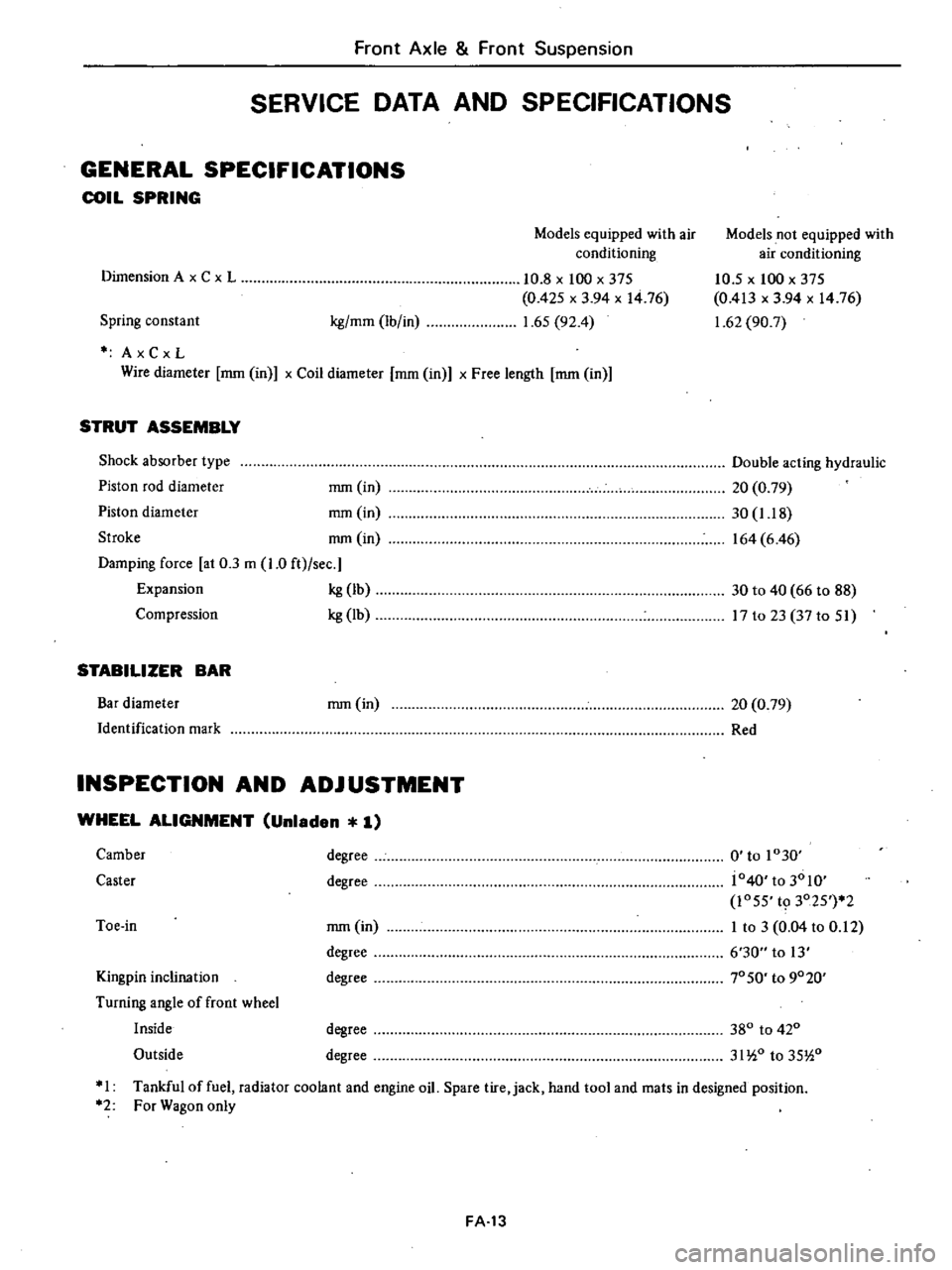
Front
Axle
Front
Suspension
SERVICE
DATA
AND
SPECIFICATIONS
GENERAL
SPECIFICATIONS
COIL
SPRING
Models
equipped
with
air
conditioning
Models
not
equipped
with
air
conditioning
10
5
x
100
x
375
0
413
x
3
94
x
1476
1
62
90
7
Spring
constant
kg
mm
Ib
in
10
8
x
100
x
375
0
425
x
3
94
x
1476
1
65
92
4
Dimension
A
x
C
x
L
AxCxL
Wire
diameter
mm
in
x
Coil
diameter
mm
in
x
Free
length
mm
in
STRUT
ASSEMBLY
Shock
absorber
type
Piston
rod
diameter
mm
in
Piston
diameter
mm
in
Stroke
nun
in
Damping
force
at
0
3
m
1
0
ft
sec
Expansion
kg
Ib
Compression
kg
Ib
Double
acting
hydraulic
20
0
79
30
1
18
164
6
46
30
to
40
66
to
88
17
to
23
37
to
51
STABILIZER
BAR
Bar
diameter
Identification
mark
mm
in
20
0
79
Red
INSPECTION
AND
ADJUSTMENT
WHEEL
ALIGNMENT
Unladen
1
Kingpin
inclination
Turning
angle
of
front
wheel
Inside
Outside
mm
in
degree
degree
0
to
1030
j040
to
3010
1055
t9
3025
2
I
to
3
0
04
to
0
12
6
30
to
13
70
SO
to
9020
Camber
Caster
degree
degree
Toe
in
degree
degree
380
to
420
31
io
to
35
i0
I
Tankful
of
fuel
radiator
coolant
and
engine
oil
Spare
tire
jack
hand
tool
and
mats
in
designed
position
2
For
Wagon
only
FA
13
Page 336 of 548

WHEEL
BEARING
Wheel
bearing
axial
play
Wheel
bearing
nut
tightening
torque
Return
angle
Rotation
starting
torque
With
new
grease
seal
With
used
grease
seal
At
wheel
hub
bolt
With
new
grease
seal
With
used
grease
seal
SUSPENSIONBA
JOINT
Turning
torque
New
parts
Used
parts
TIGHTENIN
TORQUE
LOWERBAl
L
JOINT
Ball
joint
socket
to
lower
arm
Ball
joint
to
knuckle
arm
Stud
nut
STRUT
Steering
knuckle
arm
to
strut
Strut
to
hoodledge
Piston
rod
self
locking
nut
Gland
packing
DISC
BRAKE
Rotor
to
hub
SIDE
ROD
Side
rod
ball
jOIDt
to
knuckle
arm
LOWER
ARM
Lower
arm
bolt
nut
Side
rod
adjusting
nut
TENSION
ROD
Tension
rod
bushing
installation
nut
Tension
rod
to
lower
arm
Tension
rod
bracket
to
body
Frpn
Axle
Front
Suspension
mm
in
0
0
kg
m
ft
lb
degree
3
0
to
3
5
22
to
25
900
kg
cm
in
lbr
kg
em
in
Ib
Less
than
7
0
6
1
1
0
to
4
5
0
9
to
3
9
kg
lb
kg
lb
Less
than
1
2
2
6
0
1
7
to
0
79
0
37
to
1
74
kg
cm
in
Ib
kg
cm
in
Ib
40
to
100
35
to
87
More
than
20
17
kg
m
ft
Ib
5
1
to
6
1
37
to
44
5
5
to
10
0
40
to
72
7
3
to
9
9
53
to
72
2
5
to
3
5
18
to
25
6
0
to
7
5
43
to
54
8
0
to
11
0
58
to
80
3
9
to
5
3
28
to
38
3
0
to
7
0
22
to
51
3
9
to
5
0
2810
36
8
0
to
10
0
58
to
72
4
5
to
5
1
33
to
37
5
1
to
6
1
37
to
44
3
2
to
4
3
23
to
31
FA
14
Page 337 of 548

Front
Axle
Front
Suspension
STABILIZER
BAR
Stabilizer
bar
bracket
Stabilizer
bar
connecting
rod
1
6
to
2
1
12
to
15
1
6
to
2
1
12
to
15
SUSPENSION
CROSSMEMBER
Suspension
member
to
body
frame
Engine
mounting
insulator
to
suspension
member
3
2
to
4
3
23
to
31
3
2
to
4
3
23
to
31
FA
15
Page 338 of 548
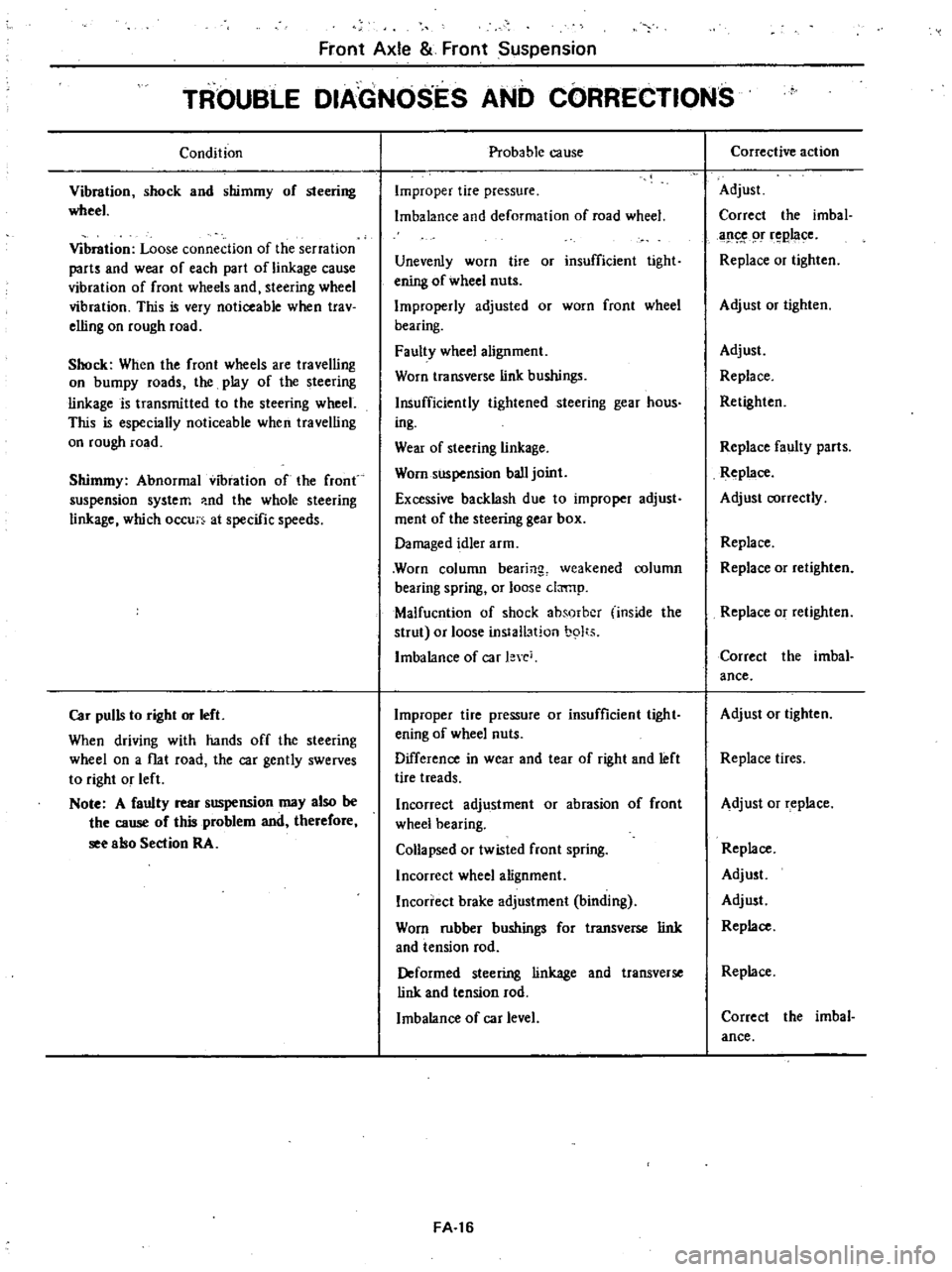
Front
Axle
Front
Suspension
TROUBLE
DIAGNOSES
AND
CORRECTIONS
Condition
Vibration
shock
and
shimmy
of
steering
wheel
Vibration
Loose
connection
of
the
serration
parts
and
wear
of
each
part
of
linkage
cause
vibration
of
front
wheels
and
steering
wheel
vibration
This
is
very
noticeable
when
trav
elling
on
rough
road
Shock
When
the
front
wheels
are
travelling
on
bumpy
roads
the
play
of
the
steering
linkage
is
transmitted
to
the
steering
wheel
This
is
especially
noticeable
when
travelling
on
rough
road
Shimmy
Abnormal
vibration
of
the
front
suspension
system
nd
the
whole
steering
linkage
which
occu
at
specific
speeds
Car
pulls
to
right
or
left
When
driving
with
hands
off
the
steering
wheel
on
a
flat
road
the
car
gently
swerves
to
right
or
left
Note
A
faulty
rear
suspension
may
also
be
the
cause
of
this
problem
and
therefore
see
ebo
Section
RA
Proba
b
Ie
ca
use
Improper
tire
pressure
Imbalance
and
deformation
of
road
wheel
Unevenly
worn
tire
or
insufficient
tight
ening
of
wheel
nuts
Improperly
adjusted
or
worn
front
wheel
bearing
Faulty
wheel
alignment
Worn
transverse
link
bushings
Insufficiently
tightened
steering
gear
hous
ing
Wear
of
steering
linkage
Worn
suspension
ball
joint
Excessive
backlash
due
to
improper
adjust
ment
of
the
steering
gear
box
Damaged
idler
arm
Worn
column
bearing
weakened
column
bearing
spring
or
loose
drmp
Malfucntion
of
shock
absorber
inside
the
strut
or
loose
install3t
on
b9
t5
Imbalance
of
car
l
e
Improper
tire
pressure
or
insufficient
tight
ening
of
wheel
nuts
Difference
in
wear
and
tear
of
right
and
left
tire
treads
Incorrect
adjustment
or
abrasion
of
front
wheel
bearing
Collapsed
or
twisted
front
spring
Incorrect
wheel
alignment
Incorrect
brake
adjustment
binding
Worn
rubber
bushings
for
transverse
link
and
tension
rod
Deformed
steering
linkage
and
transverse
link
and
tension
rod
Imbalance
of
car
level
FA
16
Corrective
action
Adjust
Correct
the
imbal
ap
9f
r
B4I
e
Replace
or
tighten
Adjust
or
tighten
Adjust
Replace
Retighten
Replace
faulty
parts
Replace
Adjust
correctly
Replace
Replace
or
retighten
Replace
or
retighten
Correct
the
imbal
ance
Adjust
or
tighten
Replace
tires
Adjust
or
replace
Replace
Adjust
Adjust
Replace
Replace
Correct
the
imbal
ance
Page 339 of 548
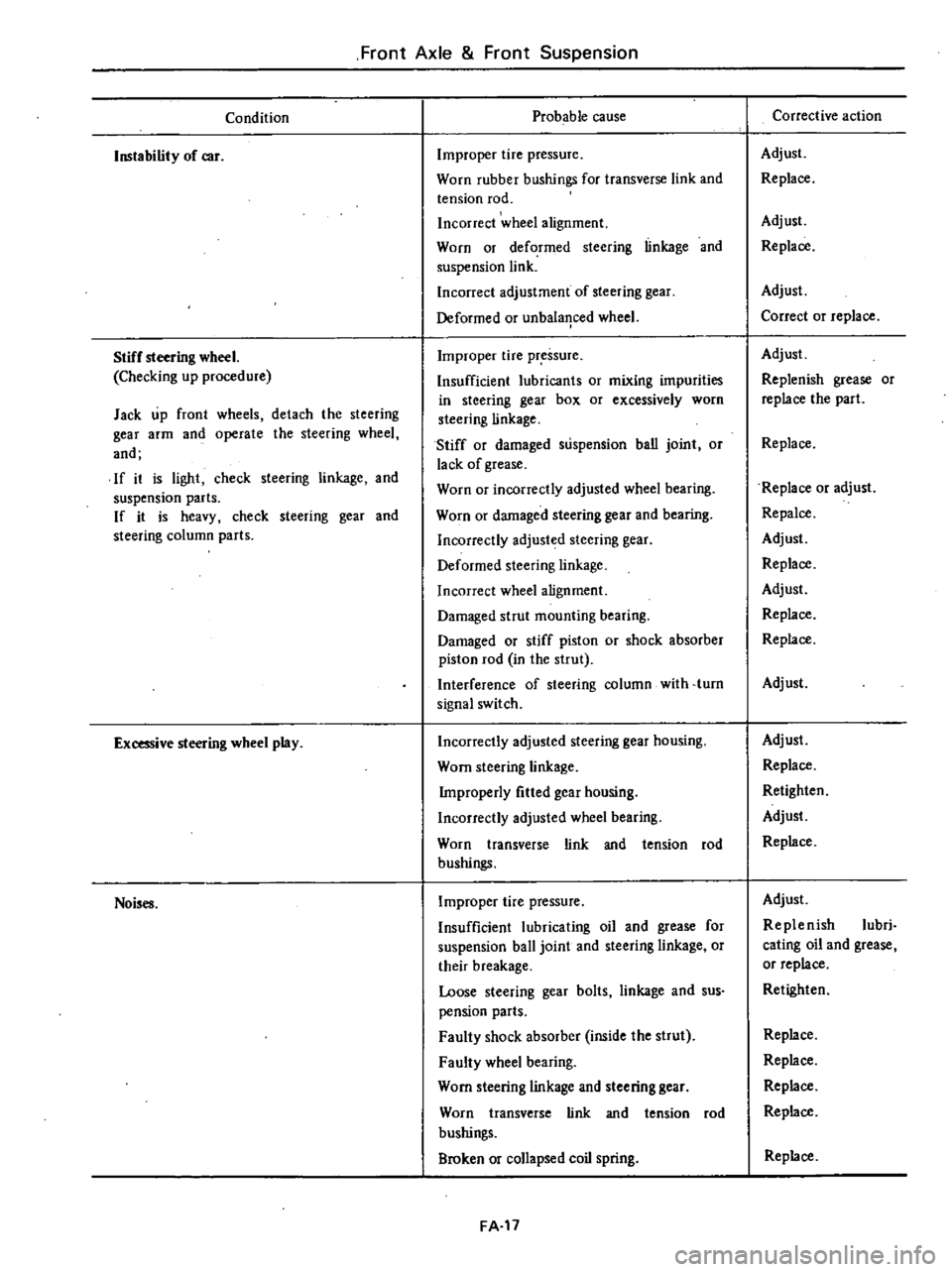
Front
Axle
Front
Suspension
Condition
Instability
of
car
Stiff
steering
wheel
Checking
up
procedure
Jack
up
front
wheels
detach
the
steering
gear
arm
and
operate
the
steering
wheel
and
If
it
is
light
check
steering
linkage
and
suspension
parts
If
it
is
heavy
check
steering
gear
and
steering
column
parts
Excessive
steering
wheel
play
Noises
Probable
cause
Improper
tire
pressure
Worn
rubber
bushings
for
transverse
link
and
tension
rod
Incorrect
wheel
alignment
Worn
or
deformed
steering
linkage
and
suspension
link
Incorrect
adjustment
of
steering
gear
Deformed
or
unbala
1ced
wheel
Improper
tire
pressure
Insufficient
lubricants
or
mixing
impurities
in
steering
gear
box
or
excessively
worn
steering
linkage
Stiff
or
damaged
suspension
ban
joint
or
lack
of
grease
Worn
or
incorrectly
adjusted
wheel
bearing
Worn
or
damaged
steering
gear
and
bearing
Incorrectly
adjusted
steering
gear
Deformed
steering
linkage
Incorrect
wheel
alignment
Damaged
strut
mounting
bearing
Damaged
or
stiff
piston
or
shock
absorber
piston
rod
in
the
strut
Interference
of
steering
column
with
turn
signal
switch
Incorrectly
adjusted
steering
gear
housing
Worn
steering
linkage
Improperly
fitted
gear
housing
Incorrectly
adjusted
wheel
bearing
Worn
transverse
link
and
tension
rod
bushings
Improper
tire
pressure
Insufficient
lubricating
oil
and
grease
for
suspension
ball
joint
and
steering
linkage
or
their
breakage
Loose
steering
gear
bolts
linkage
and
sus
pension
parts
Faulty
shock
absorber
inside
the
strut
Faulty
wheel
bearing
Worn
steering
linkage
and
steering
gear
Worn
transverse
link
and
tension
rod
bushings
Broken
or
collapsed
coil
spring
FA
17
Corrective
action
Adjust
Replace
Adjust
Replace
Adjust
Correct
or
replace
Adjust
Replenish
grease
or
replace
the
part
Replace
Replace
or
adjust
Repalce
Adjust
Replace
Adjust
Replace
Replace
Adjust
Adjust
Replace
Retighten
Adjust
Replace
Adjust
Replenish
lubri
cating
oil
and
grease
or
replace
Retighten
Replace
Replace
Replace
Replace
Replace
Page 340 of 548
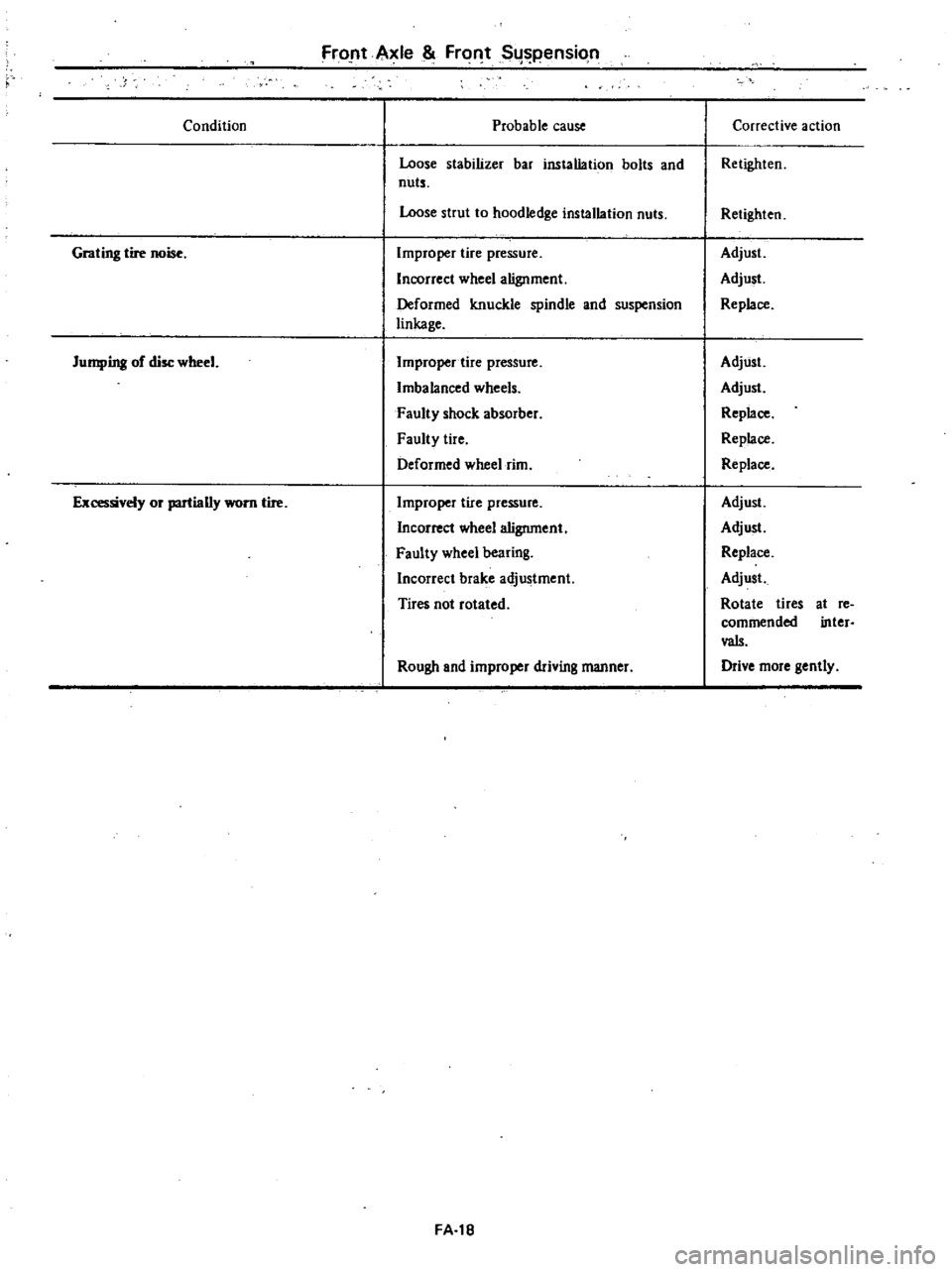
Front
Axle
Front
Suspension
Condition
Probable
cause
Loose
stabilizer
bar
installation
bolts
and
nuts
Loose
strut
to
hoodledge
installation
nuts
Grating
tire
noise
Improper
tire
pressure
Incorrect
wheel
alignment
Deformed
knuckle
spindle
and
suspension
linkage
Jumping
of
disc
wheel
Improper
tire
pressure
Imbalanced
wheels
Faulty
shock
absorber
Faulty
tire
Deformed
wheel
rim
Ex
t
J1
or
partially
worn
tire
Improper
tire
pressure
Incorrect
wheel
alignment
Faulty
wheel
bearing
Incorrect
brake
adjustment
Tires
not
rotated
Rough
and
improper
driving
manner
FA
18
Corrective
action
Retighten
Retighten
Adjust
Adjust
Replace
Adjust
Adjust
Replace
Replace
Replace
Adjust
Adjust
Replace
Adjust
Rotate
tires
commended
vaIs
Drive
more
gently
at
re
inter